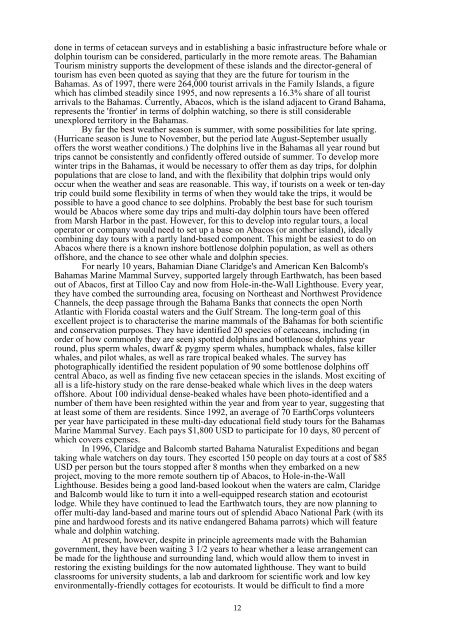The Potential of Whale Watching in the Caribbean: 1999+
The Potential of Whale Watching in the Caribbean: 1999+
The Potential of Whale Watching in the Caribbean: 1999+
Create successful ePaper yourself
Turn your PDF publications into a flip-book with our unique Google optimized e-Paper software.
done <strong>in</strong> terms <strong>of</strong> cetacean surveys and <strong>in</strong> establish<strong>in</strong>g a basic <strong>in</strong>frastructure before whale or<br />
dolph<strong>in</strong> tourism can be considered, particularly <strong>in</strong> <strong>the</strong> more remote areas. <strong>The</strong> Bahamian<br />
Tourism m<strong>in</strong>istry supports <strong>the</strong> development <strong>of</strong> <strong>the</strong>se islands and <strong>the</strong> director-general <strong>of</strong><br />
tourism has even been quoted as say<strong>in</strong>g that <strong>the</strong>y are <strong>the</strong> future for tourism <strong>in</strong> <strong>the</strong><br />
Bahamas. As <strong>of</strong> 1997, <strong>the</strong>re were 264,000 tourist arrivals <strong>in</strong> <strong>the</strong> Family Islands, a figure<br />
which has climbed steadily s<strong>in</strong>ce 1995, and now represents a 16.3% share <strong>of</strong> all tourist<br />
arrivals to <strong>the</strong> Bahamas. Currently, Abacos, which is <strong>the</strong> island adjacent to Grand Bahama,<br />
represents <strong>the</strong> 'frontier' <strong>in</strong> terms <strong>of</strong> dolph<strong>in</strong> watch<strong>in</strong>g, so <strong>the</strong>re is still considerable<br />
unexplored territory <strong>in</strong> <strong>the</strong> Bahamas.<br />
By far <strong>the</strong> best wea<strong>the</strong>r season is summer, with some possibilities for late spr<strong>in</strong>g.<br />
(Hurricane season is June to November, but <strong>the</strong> period late August-September usually<br />
<strong>of</strong>fers <strong>the</strong> worst wea<strong>the</strong>r conditions.) <strong>The</strong> dolph<strong>in</strong>s live <strong>in</strong> <strong>the</strong> Bahamas all year round but<br />
trips cannot be consistently and confidently <strong>of</strong>fered outside <strong>of</strong> summer. To develop more<br />
w<strong>in</strong>ter trips <strong>in</strong> <strong>the</strong> Bahamas, it would be necessary to <strong>of</strong>fer <strong>the</strong>m as day trips, for dolph<strong>in</strong><br />
populations that are close to land, and with <strong>the</strong> flexibility that dolph<strong>in</strong> trips would only<br />
occur when <strong>the</strong> wea<strong>the</strong>r and seas are reasonable. This way, if tourists on a week or ten-day<br />
trip could build some flexibility <strong>in</strong> terms <strong>of</strong> when <strong>the</strong>y would take <strong>the</strong> trips, it would be<br />
possible to have a good chance to see dolph<strong>in</strong>s. Probably <strong>the</strong> best base for such tourism<br />
would be Abacos where some day trips and multi-day dolph<strong>in</strong> tours have been <strong>of</strong>fered<br />
from Marsh Harbor <strong>in</strong> <strong>the</strong> past. However, for this to develop <strong>in</strong>to regular tours, a local<br />
operator or company would need to set up a base on Abacos (or ano<strong>the</strong>r island), ideally<br />
comb<strong>in</strong><strong>in</strong>g day tours with a partly land-based component. This might be easiest to do on<br />
Abacos where <strong>the</strong>re is a known <strong>in</strong>shore bottlenose dolph<strong>in</strong> population, as well as o<strong>the</strong>rs<br />
<strong>of</strong>fshore, and <strong>the</strong> chance to see o<strong>the</strong>r whale and dolph<strong>in</strong> species.<br />
For nearly 10 years, Bahamian Diane Claridge's and American Ken Balcomb's<br />
Bahamas Mar<strong>in</strong>e Mammal Survey, supported largely through Earthwatch, has been based<br />
out <strong>of</strong> Abacos, first at Tilloo Cay and now from Hole-<strong>in</strong>-<strong>the</strong>-Wall Lighthouse. Every year,<br />
<strong>the</strong>y have combed <strong>the</strong> surround<strong>in</strong>g area, focus<strong>in</strong>g on Nor<strong>the</strong>ast and Northwest Providence<br />
Channels, <strong>the</strong> deep passage through <strong>the</strong> Bahama Banks that connects <strong>the</strong> open North<br />
Atlantic with Florida coastal waters and <strong>the</strong> Gulf Stream. <strong>The</strong> long-term goal <strong>of</strong> this<br />
excellent project is to characterise <strong>the</strong> mar<strong>in</strong>e mammals <strong>of</strong> <strong>the</strong> Bahamas for both scientific<br />
and conservation purposes. <strong>The</strong>y have identified 20 species <strong>of</strong> cetaceans, <strong>in</strong>clud<strong>in</strong>g (<strong>in</strong><br />
order <strong>of</strong> how commonly <strong>the</strong>y are seen) spotted dolph<strong>in</strong>s and bottlenose dolph<strong>in</strong>s year<br />
round, plus sperm whales, dwarf & pygmy sperm whales, humpback whales, false killer<br />
whales, and pilot whales, as well as rare tropical beaked whales. <strong>The</strong> survey has<br />
photographically identified <strong>the</strong> resident population <strong>of</strong> 90 some bottlenose dolph<strong>in</strong>s <strong>of</strong>f<br />
central Abaco, as well as f<strong>in</strong>d<strong>in</strong>g five new cetacean species <strong>in</strong> <strong>the</strong> islands. Most excit<strong>in</strong>g <strong>of</strong><br />
all is a life-history study on <strong>the</strong> rare dense-beaked whale which lives <strong>in</strong> <strong>the</strong> deep waters<br />
<strong>of</strong>fshore. About 100 <strong>in</strong>dividual dense-beaked whales have been photo-identified and a<br />
number <strong>of</strong> <strong>the</strong>m have been resighted with<strong>in</strong> <strong>the</strong> year and from year to year, suggest<strong>in</strong>g that<br />
at least some <strong>of</strong> <strong>the</strong>m are residents. S<strong>in</strong>ce 1992, an average <strong>of</strong> 70 EarthCorps volunteers<br />
per year have participated <strong>in</strong> <strong>the</strong>se multi-day educational field study tours for <strong>the</strong> Bahamas<br />
Mar<strong>in</strong>e Mammal Survey. Each pays $1,800 USD to participate for 10 days, 80 percent <strong>of</strong><br />
which covers expenses.<br />
In 1996, Claridge and Balcomb started Bahama Naturalist Expeditions and began<br />
tak<strong>in</strong>g whale watchers on day tours. <strong>The</strong>y escorted 150 people on day tours at a cost <strong>of</strong> $85<br />
USD per person but <strong>the</strong> tours stopped after 8 months when <strong>the</strong>y embarked on a new<br />
project, mov<strong>in</strong>g to <strong>the</strong> more remote sou<strong>the</strong>rn tip <strong>of</strong> Abacos, to Hole-<strong>in</strong>-<strong>the</strong>-Wall<br />
Lighthouse. Besides be<strong>in</strong>g a good land-based lookout when <strong>the</strong> waters are calm, Claridge<br />
and Balcomb would like to turn it <strong>in</strong>to a well-equipped research station and ecotourist<br />
lodge. While <strong>the</strong>y have cont<strong>in</strong>ued to lead <strong>the</strong> Earthwatch tours, <strong>the</strong>y are now plann<strong>in</strong>g to<br />
<strong>of</strong>fer multi-day land-based and mar<strong>in</strong>e tours out <strong>of</strong> splendid Abaco National Park (with its<br />
p<strong>in</strong>e and hardwood forests and its native endangered Bahama parrots) which will feature<br />
whale and dolph<strong>in</strong> watch<strong>in</strong>g.<br />
At present, however, despite <strong>in</strong> pr<strong>in</strong>ciple agreements made with <strong>the</strong> Bahamian<br />
government, <strong>the</strong>y have been wait<strong>in</strong>g 3 1/2 years to hear whe<strong>the</strong>r a lease arrangement can<br />
be made for <strong>the</strong> lighthouse and surround<strong>in</strong>g land, which would allow <strong>the</strong>m to <strong>in</strong>vest <strong>in</strong><br />
restor<strong>in</strong>g <strong>the</strong> exist<strong>in</strong>g build<strong>in</strong>gs for <strong>the</strong> now automated lighthouse. <strong>The</strong>y want to build<br />
classrooms for university students, a lab and darkroom for scientific work and low key<br />
environmentally-friendly cottages for ecotourists. It would be difficult to f<strong>in</strong>d a more<br />
12
















